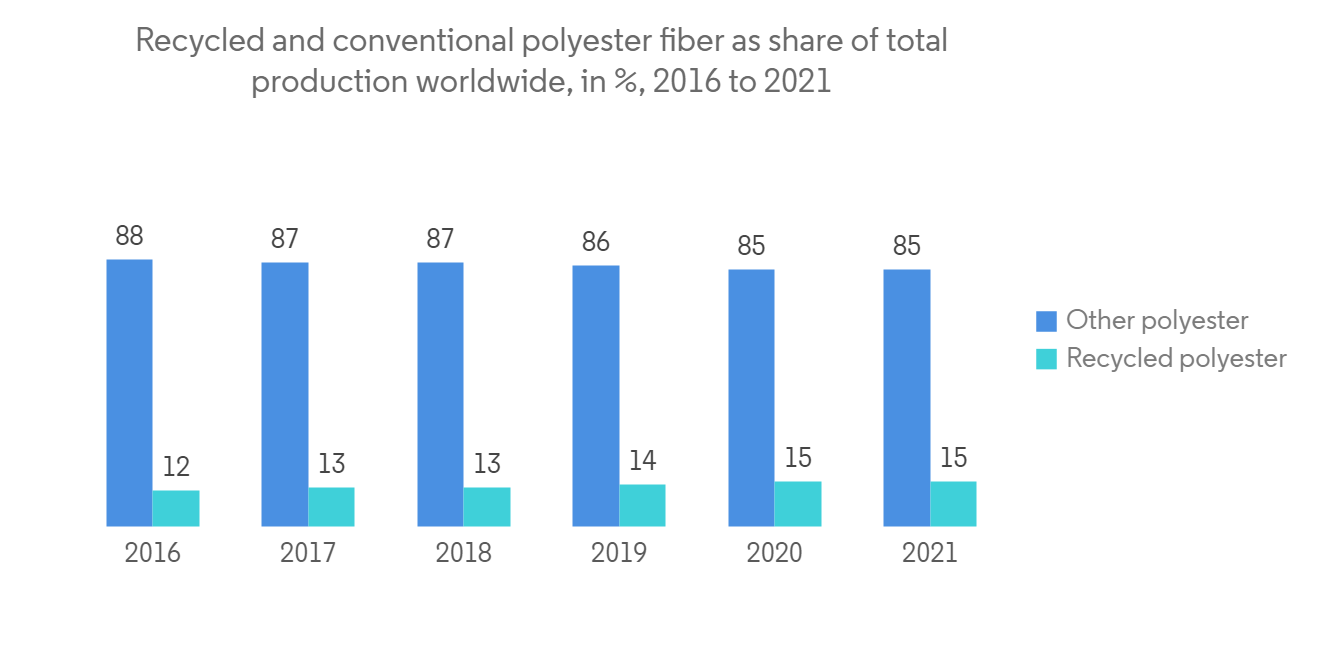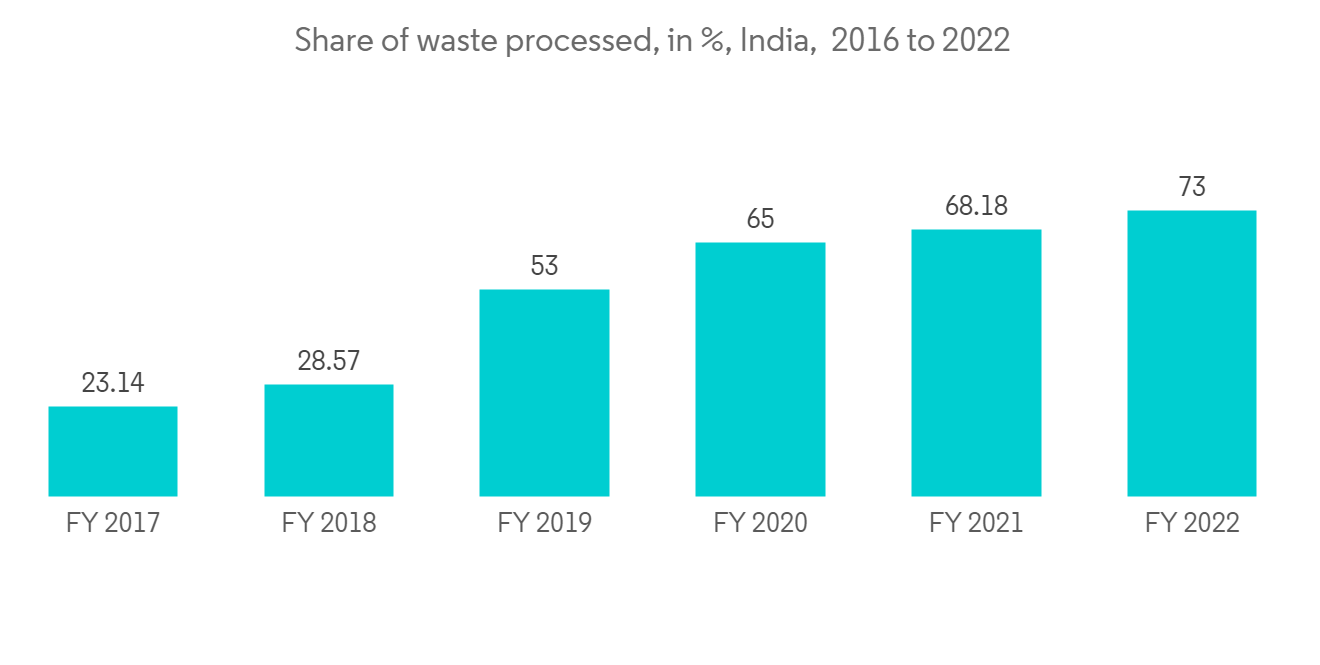 |
市場調査レポート
商品コード
1258786
繊維廃棄物管理市場- 成長、動向、予測(2023年-2028年)Textile Waste Management Market - Growth, Trends, and Forecasts (2023 - 2028) |
||||||
● お客様のご希望に応じて、既存データの加工や未掲載情報(例:国別セグメント)の追加などの対応が可能です。 詳細はお問い合わせください。
| 繊維廃棄物管理市場- 成長、動向、予測(2023年-2028年) |
|
出版日: 2023年04月14日
発行: Mordor Intelligence
ページ情報: 英文 150 Pages
納期: 2~3営業日
|
- 全表示
- 概要
- 目次
繊維廃棄物管理市場は予測期間中に3%以上のCAGRで推移する見込み
主なハイライト
- 繊維リサイクル市場は、人々のリサイクル意識の高まりと環境への配慮から成長が見込まれています。さらに、COVID-19の大流行が世界市場の成長に悪影響を及ぼしました。繊維リサイクル業界は、リサイクル前工程を実行するための制約や障害により、後退に直面しています。
- その結果、衣料品や繊維製品は倉庫に積み上げられ、市場開拓を遅らせています。米国では、さまざまな取り組みや新興企業が人気を集めており、繊維製品のリサイクル率の上昇に大きく寄与しています。ATRS(American Textile Recycling Services)は、衣類、履物、家庭用品の寄付や回収サービスを行う寄付金箱の運営会社です。ATRSは、衣料品や履物、家庭用品の寄付・回収サービスを行う寄付箱の運営会社で、全米の新しい場所に次々と進出し、リサイクルの拡大を加速しています。
- さらに、リサイクル手順の進歩や業界における新たな調査も、市場拡大を助けると予想されます。例えば、2022年2月に開催されたセルロース繊維に関する国際会議において、LIST Technology AGは、繊維リサイクル事業における大きな前進として、すべてリサイクルされたリヨセルTシャツを発表しました。十分なリサイクル可能な素材の入手や利用が制限されているため、市場の拡大が厳しく制限されています。ほとんどの場合、生地素材が組み合わされているため、選別手順とその後のリサイクルが困難になっています。また、新興諸国では非正規のベンダーが回収・選別を行っており、これが全体のリサイクル率や市場拡大に影響を与えています。
繊維廃棄物管理市場の動向
ポリエステルのリサイクル産業は急成長すると予測される
ポリエステルのリサイクルは、ファッション業界においてより多くの需要があるため、速度を上げています。企業は、通常のポリエステルに代わって、より多くのリサイクルポリエステルを衣服に使用することを約束しています。ポリアミドのリサイクルの大部分はナイロンを使用しており、そのリサイクルの大部分はケミカルリサイクル法で行われています。ナイロンのリサイクルは技術的な困難が多く、現在ではナイロンのリサイクルを行う事業者は数社にとどまっています。リサイクルに使われるポリアミドは、ほとんどが使用済みの布地からですが、すでに使用された漁網のようなものから出ることもあります。
そして2022年12月、米国の国立再生可能エネルギー研究所(NREL)の科学者が、廃ポリエステル生地やボトルのリサイクルを、石油から生産するよりも安くできるかもしれない酵素を発見しました。NRELの研究者たちは、あらゆる種類のポリエチレンテレフタレート(PET)、それも長持ちする結晶性のものまで分解できるさまざまな酵素を考え出しました。
ポリエステルの廃棄物を取り除くと、リサイクルPETからポリエステル糸を作ることができます。この糸は一次加工されたポリエステルと同じ性質を持っているので、新しいものを作るためのエネルギーが少なくて済むのです。ポリエステルゴミのリサイクルは、エネルギー消費を抑え、環境中のプラスチックゴミの拡散をなくすだけでなく、その後の製造コストを削減し、高品質の商品を作ることができます。

アジア太平洋地域が世界の繊維廃棄物管理産業を支配した
地域別市場の成長には、今後の新規プロジェクトやインド政府による統合テキスタイルパークの設立計画が寄与しています。また、米国や欧州などへ送られる繊維製品が増えており、中国、インド、バングラデシュ、ベトナムが重要な繊維国であることも、市場拡大の可能性を高めています。また、繊維廃棄物の管理は、廃水処理場が市場の一部を占めており、今後4年間もその傾向が続くと思われます。世界中で水不足や清潔な水の供給が失われるという環境問題に対処する必要があることが、この産業の成長を後押ししています。
また、アジア太平洋市場では、再生生地やプラスチックなどのオーガニック原料を使用したエコロジー衣料が誕生し、活気を呈しています。そのほか、衣類の戸別集荷の人気や、公共の場での衣類回収ボックスの設置も、成長の主な要因となっています。そして、快適であるなどの利点があるため、ハウス素材を選択する人が増えていることも、市場の成長につながっています。さらに、アジア太平洋地域の繊維リサイクル市場は、大手企業が自動選別アプリケーションの新技術を生み出すことで、今後数年間は成長すると予想されます。

繊維廃棄物管理業界の概要
エンドユーザーの需要によって業界に強い競争が生まれ、その結果、産業が細分化されたのです。インフィニット・ファイバー・カンパニー(IFC)は、テキスタイルのリサイクルに多くの投資を行っています。同社は最近、H&Mグループ、RGE Pte Ltd、Virala、シンガポールのFortumなど、有名メーカーの支援を得て、リサイクル技術の開発に取り組んでいます。
世界の繊維廃棄物管理業界は、革新的な技術に投資していくと予測されます。さらに、これらのサプライヤーの成功は、生生産を受け入れる意思に大きく依存しています。Worn Again Technologies、Re:NewCell、Pistoni S.r.l.は、この業界の重要な企業のひとつです。
その他の特典:
- エクセル形式の市場予測(ME)シート
- 3ヶ月のアナリストサポート
目次
第1章 イントロダクション
- 調査の成果
- 調査の前提条件条件
- 調査対象範囲
第2章 調査手法
第3章 エグゼクティブサマリー
第4章 市場の洞察と力学
- 市場概要
- 市場促進要因
- 市場抑制要因/課題
- マーケットオポチュニティ
- バリューチェーン/サプライチェーン分析
- ポーターのファイブフォース分析
- 新規参入業者の脅威
- 買い手/消費者の交渉力
- 供給企業の交渉力
- 代替品の脅威
- 競争企業間の敵対関係の強さ
- 業界における技術革新
- 産業界への投資誘致に向けた政府の取り組み
- COVID-19が業界に与える影響について
第5章 市場セグメンテーション
- 廃棄物別
- 危険
- プラスチック
- ポリエステル
- その他の廃棄物
- サービス別
- オープンダンピング
- 焼却
- 埋立地
- リサイクル
- エンドユーザー別
- 住宅用
- コマーシャル
- インダストリアル
- その他のエンドユーザー
- 地域別
- 北米
- 米国
- カナダ
- メキシコ
- 欧州
- ドイツ
- フランス
- 英国
- イタリア
- スペイン
- ロシア
- その他欧州
- アジア太平洋地域
- 中国
- 日本
- インド
- バングラデシュ
- トルコ
- 韓国
- オーストラリア
- インドネシア
- その他アジア太平洋地域
- 中東・アフリカ地域
- エジプト
- 南アフリカ
- サウジアラビア
- その他中東とアフリカ
- 南米
- ブラジル
- アルゼンチン
- その他南米地域
- 北米
第6章 競合情勢について
- 市場集中の概要
- 企業プロファイル
- Worn Again Technologies
- Veolia Environnement S.A.
- Boer Group
- Re:NewCell
- Pistoni S.r.l
- Lenzing AG
- Textile Recycling International
- RE TEXTIL Deutschland GmbH
- Hyosung Group
- Infinited Fiber Company
第7章 市場機会と今後の動向
第8章 付録
- GDPの分布:活動別
- 資本フローに関する洞察
The Textile Waste Management Market is expected to register a CAGR of over 3% during the forecast period.
Key Highlights
- The textile recycling market is expected to grow because people are becoming more aware of recycling and because they care more about the environment.Furthermore, the COVID-19 pandemic had a detrimental influence on worldwide market growth. The textile recycling industry is facing a setback due to constraints and impediments to executing the pre-recycling process.
- As a result, garments and textiles are stacked up in warehouses, slowing market development. Various initiatives and start-ups are gaining traction in the United States, contributing considerably to the rising rate of textile recycling. ATRS (American Textile Recycling Services) is the donation bin operator for clothes, footwear, and household items donation and collection services. ARTS is constantly extending to new locations around the country, accelerating the expansion of recycling.
- Furthermore, advancements in recycling procedures and new research in the industry are expected to aid market expansion. For example, at the International Conference on Cellulose Fibers in February 2022, LIST Technology AG presented an all-recycled lyocell t-shirt as a major step forward in the textile recycling business. The restricted availability and accessibility of sufficient recyclable material severely limits market expansion. Most of the time, the fabric material is combined, making the sorting procedure and subsequent recycling difficult. Additionally, informal vendors carry out the collecting and sorting process in less developed countries, which has an impact on the overall recycling rate and market expansion.
Textile Waste Management Market Trends
The Polyester Recycling Industry Is Predicted To Grow At A Rapid Pace
Polyester recycling is picking up speed because there is more demand for it in the fashion industry. Companies have promised to use more recycled polyester in clothes by replacing regular polyester.The majority of polyamide recycling is done using nylon, and the majority of the recycling is done using the chemical recycling method. The nylon recycling process is filled with technological difficulties, and there are now just a few businesses that recycle nylon. Polyamide used for recycling comes mostly from used fabric, but it can also come from things like fishing nets that have already been used.
And in December 2022, scientists at the National Renewable Energy Laboratory (NREL) in the United States found enzymes that might make recycling waste polyester fabrics and bottles cheaper than producing them from petroleum. Researchers at NREL came up with different enzymes that can break down all types of polyethylene terephthalate (PET), even the kind that lasts a long time and is crystalline.
When polyester waste is taken away, it is possible to make polyester yarn from recycled PET. This yarn has the same properties as first-process polyester, so it uses less energy to make new things. Polyester trash recycling not only reduces energy consumption and eliminates plastic waste dispersion in the environment, but it also saves money on subsequent manufacturing and high-quality goods.

Asia Pacific Region Dominated The Global Textile Waste Management Industry
Regional market growth is helped by upcoming new projects and plans by the Indian government to set up integrated textile parks. Also, more textiles are being sent to places like the U.S. and Europe, and the fact that China, India, Bangladesh, and Vietnam are important textile countries makes the market more likely to grow. Also, wastewater treatment plants dominated a part of the market for managing textile waste, and they are likely to continue to do so over the next four years. The need to address environmental concerns about water shortages and the loss of clean water supplies around the world is what is driving the growth of this industry.
The Asia-Pacific market is also getting a boost from the creation of eco-clothes made from recycled fabrics, plastics, and other organic raw materials. Aside from that, the popularity of door-to-door clothing pickup and the installation of clothing collection bins in public places are key growth drivers. And the market is growing because more people are choosing house materials because they are comfortable and have other benefits. Moreover, the Asia-Pacific textile recycling market is expected to grow over the next few years as leading companies create new technologies for automated sorting applications.

Textile Waste Management Industry Overview
The market is broken up because recycled textiles are being used in more and more consumer sectors to help make other products.End-user demand has created strong competition in the industry, resulting in industrial fragmentation. The Infinited Fiber Company (IFC) has invested much in textile recycling. The firm recently gained backing from well-known manufacturers to develop its recycling technology, including H&M Group, RGE Pte Ltd., Virala, and Singapore-based Fortum.
The global textile waste management industry is projected to invest in innovative technologies. Furthermore, the success of these suppliers is heavily reliant on their willingness to accept raw production. Worn Again Technologies, Re:NewCell, and Pistoni S.r.l. are a few of the industry's significant players.
Additional Benefits:
- The market estimate (ME) sheet in Excel format
- 3 months of analyst support
TABLE OF CONTENTS
1 INTRODUCTION
- 1.1 Study Deliverables
- 1.2 Study Assumptions
- 1.3 Scope of the Study
2 RESEARCH METHODOLOGY
3 EXECUTIVE SUMMARY
4 MARKET INSIGHTS AND DYNAMICS
- 4.1 Market Overview
- 4.2 Market Drivers
- 4.3 Market Restraints/Challenges
- 4.4 Market Opportunities
- 4.5 Value Chain/Supply Chain Analysis
- 4.6 Porter's Five Forces Analysis
- 4.6.1 Threat of New Entrants
- 4.6.2 Bargaining Power of Buyers/Consumers
- 4.6.3 Bargaining Power of Suppliers
- 4.6.4 Threat of Substitute Products
- 4.6.5 Intensity of Competitive Rivalry
- 4.7 Technological Innovations in the industry
- 4.8 Government Initiatives to Attract Investment in the Industry
- 4.9 Impact of COVID - 19 on the Industry
5 MARKET SEGMENTATION
- 5.1 By Waste
- 5.1.1 Hazardous
- 5.1.2 Plastic
- 5.1.3 Polyester
- 5.1.4 Other Wastes
- 5.2 By Service
- 5.2.1 Open dumping
- 5.2.2 Incineration
- 5.2.3 Landfil
- 5.2.4 Recycling
- 5.3 By End-User
- 5.3.1 Residential
- 5.3.2 Commercial
- 5.3.3 Industrial
- 5.3.4 Other End-Users
- 5.4 By Geography
- 5.4.1 North America
- 5.4.1.1 United States
- 5.4.1.2 Canada
- 5.4.1.3 Mexico
- 5.4.2 Europe
- 5.4.2.1 Germany
- 5.4.2.2 France
- 5.4.2.3 United Kingdom
- 5.4.2.4 Italy
- 5.4.2.5 Spain
- 5.4.2.6 Russia
- 5.4.2.7 Rest of Europe
- 5.4.3 Asia-Pacific
- 5.4.3.1 China
- 5.4.3.2 Japan
- 5.4.3.3 India
- 5.4.3.4 Bangladesh
- 5.4.3.5 Turkey
- 5.4.3.6 South Korea
- 5.4.3.7 Australia
- 5.4.3.8 Indonesia
- 5.4.3.9 Rest of Asia-Pacific
- 5.4.4 Middle East & Africa
- 5.4.4.1 Egypt
- 5.4.4.2 South Africa
- 5.4.4.3 Saudi Arabia
- 5.4.4.4 Rest of Middle East & Africa
- 5.4.5 South America
- 5.4.5.1 Brazil
- 5.4.5.2 Argentina
- 5.4.5.3 Rest of South America
- 5.4.1 North America
6 COMPETITIVE LANDSCAPE
- 6.1 Market Concentration Overview
- 6.2 Company Profiles
- 6.2.1 Worn Again Technologies
- 6.2.2 Veolia Environnement S.A.
- 6.2.3 Boer Group
- 6.2.4 Re:NewCell
- 6.2.5 Pistoni S.r.l
- 6.2.6 Lenzing AG
- 6.2.7 Textile Recycling International
- 6.2.8 RE TEXTIL Deutschland GmbH
- 6.2.9 Hyosung Group
- 6.2.10 Infinited Fiber Company*
7 MARKET OPPORTUNITIES AND FUTURE TRENDS
8 APPENDIX
- 8.1 GDP Distribution, by Activity
- 8.2 Insights on Capital Flows
